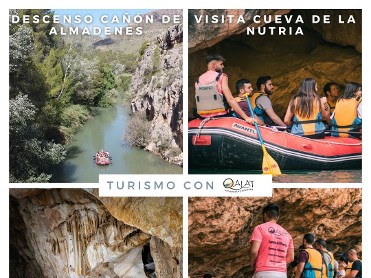Top 10
Calasparra, surrounded by four different rivers and two marshes, has one of the most amazing natural landscapes in the north-west. You will be amazed by its cave paintings, archaeological sites, culture, outdoor sports and its rice, which could be probably the best you¿ve ever tasted.
THE SACRED CAVE
The Sanctuary of the Virgen de la Esperanza (Our Lady of Hope) in Calasparra has an incomparable feature: it is situated in a cave, a natural and beautiful environment close to the Segura River. This temple, erected in the 12th century and carved in rock, houses two statues of the Virgen de la Esperanza known as La Pequeñica (the Tiny one), found by a shepherd in these caves, and La Grande (the Big one). This is a magnetic place characterised by the Marian devotion. During the night from 7th to 8th September, thousands of visitors go to the sanctuary to behold the Virgin and celebrate the well-known pilgrimage.
UNDERGROUND WORLD
Located 5 miles away from Calasparra, you will find the Cueva del Puerto, which is 3 miles long and 114 metres deep, being the largest cave of Murcia. This area is fitted out to do caving or guided tours and there is an illuminated walk of 300 metres with background music. You will get goose bumps from penetrating into a hidden world, where you will find galleries, impressive halls, astonishing stalactites and stalagmites formations, tunnels, jellyfish, chickpeas, false floors and more natural wonders with intriguing names.
THE GREATEST CANYON
Are you fond of wild and unmodified landscapes? Visiting the Almadenes Canyon will be an unforgettable experience. Poplars, ashes, willows and animals such as the Eurasian eagle owl, the short-toed eagle and the otters live in this protected natural area. In Calasparra this area is only accessible by inflatable boat or kayak. The canyon waters are extremely calm; in other words, fun is guaranteed for adults and children... you are going to repeat over and over again.
PREHISTORIC DOODLES
If you are interested in cave paintings, two must-see places are: the Abrigo del Pozo and the Cueva de Los Monigotes (the Cave of Doodles). The cave paintings of Calasparra, dated from the Eneolithic (Cooper Age) to Bronze Age, belong to the Iberian schematic art. The most dynamic way to enjoy this cultural heritage is making a descent of the Segura River, stopping to visit the Abrigo del Pozo in the middle of the tour. This adventure is suitable for the whole family.
FESTIVAL OF HOPE
Everybody knows that when you enjoy the big festivals of Calasparra, you always want to repeat. From 2nd to 8th September, the whole town is focused on the activities organised in honour of the Virgen de la Esperanza. These days, you can¿t miss the Flamenco Festival, the International Folklore Festival and the Concert of Calasparra's Band. Another interesting event is the Bull-fighting Rice Festival, with important training fights, traditional bull-running and the pilgrimage up to the Sanctuary of the Virgen de la Esperanza. This event attracts thousands of pilgrims, who walk from different parts of the city.
SAINT ABDON AND SAINT SENNEN
The celebrations in honour of the saint martyrs Abdon and Sennen take place in the last week of July. At this time, the two patrons of Calasparra, who protect farmers and crops against disasters, are remembered by its inhabitants through actions such as the Saints' procession-an open-air dance at Barrio de los Santos-, the rice tasting and bullfights at the traditional bullring La Caverina. These days, people usually make groups, then prepare and eat the famous "migas" (flour crumbs with pork or fish) and drink "cuerva", a fascinating mixture of wine with peach.
MEDIEVAL DAYS
On 7th, 8th and 9th of June, Calasparra remembers the donation of Calasparra to the Order of Saint John of Jerusalem. This event, established in 1989 to celebrate its 700th anniversary, recalls how the Order of Saint John of Jerusalem Hospital inherited the castle and all its stipulation from the King Sancho IV. Lots of activities take place and have the power to take us back to another age: the Medieval Market, popular dishes, medieval dinner, vintage parades, the performance of the Donation and many more.
HAVE A BLOW-OUT
In Calasparra, everything revolves around its best product: rice. This grain obtained the Designation of Origin and appears in most of the local dishes: rice with chicken, vegetables, rabbit and snails, or beans. There are other traditional dishes as "caldereta de toro" (bull stew), famous in the Bullfight Festival, asparagus soup, "migas", "jarullo" ("migas" with peppers and meat) and the typical Holy Week meal with cod meatballs. If you're still not convinced, you won't be able to refuse the Ruta de la Tapa y del Cóctel, a gastronomic tour celebrated annually from the middle of October to the middle of November.
FORMER MERCHANTS
On the
AN EDUCATIONAL HOLY WEEK
The Holy Week of Calasparra stands out not only for the huge involvement of the inhabitants, but also for its teaching and enriching nature. This celebration, which began in the 15th century and was declared of Regional Touristic Interest, holds some remarkable ceremonies, such as the Capture of Jesus. This performance occurs on the streets on Holy Wednesday and a group of romans called "los Picas" plays the leading role. On Easter Sunday, after "El Caracol", a parade of bands formed by cornets and drums, locals usually go to the countryside to eat the traditional "Hornazo" (a meat pie).



